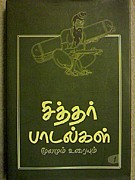私の提出した論文です。(ジャーナルには掲載されませんでしたのでここに公表ってことで)
ポイントは後ほど日本語訳しますが。
Evidences of Longevity
Every person in this world is wishing if he were immortal; or if he could live long without suffering. My country people, Japanese, have been expected to give a hint for their research of “longevity” by many modern scientists all over the world. Japanese bestow the longest average life of the world over 25 years: 83 years . Why and how do they live so long?
Like as worldwide scientists, this paper is to analyze the reasons of longevity of Japanese as well, but, through Siddha principles. Moreover, unlike other scientific researches, this paper proves 3 facts: Siddha system of medicine is universal, Siddha system could analyze the reason of Japanese longevity much more deeply than modern science, and Siddha system of science does not finish as a theory and is very effective in practical basis to achieve our long life if it is practiced.
First of all, in this case, Ceyarkkai vanmai is having a bigger factor than Iyarukkai vanmai. The average life span of Japanese was only about 50 years before World War 2 . It means the longevity of Japanese is not due to inborn qualities, but it is something which has been built up. Many years, Japan has been having much longer life than any other developed countries with strong public health improvement like Japan, indicates some factors other than sanitation is the main reason of their longevity.
Therefore, the secret of the longevity of Japanese must be mainly based on Ceyarkkai vanmai, their way of life, more than genetic or sanitation factors. Nowadays, many Scientists have discovered the Japanese food is the key. However, Siddha principle considering Ceyarkkai Vanmmai can further prove that the reason is not only food, but also their customs. This paper gives an analysis on the reason of the longevity of Japanese by viewing factors based on ceyarkkai vanmai of Japanese people: 1) Food, 2) Food Habits, and 3) General Customs.
Japanese food is world famous as healthy food; it has been introduced to many European countries and America as the healthiest food of the world. Its reason is easily revealed if we view through Siddha concept. The custom of Japanese food has a certain role of cooking, which could be a follower model of Siddha concept of healthy food: “5 laws” - 5 tastes, 5 ways of preparations, 5 colors, 5 suitability, and 5 senses .
First, The Japanese food can be the ideal diet of the balanced food which Siddhars have humbly mentioned. It contains 6 tastes. The law of “5 tastes” indicates salt, bitter, pungent, sour, and sweet. However, in Japan, it is quite usual to take green tea along with food, which has astringent and bitter tastes. It actually makes the diet composed of perfect 6 tastes!-the most balanced diet in our system.
Japanese cuisine gives an importance to choose food ingredients according to the 5 colors: black, yellow, red, white, and green. It can be compared as the 3 humors: green and white for Kapham, black for Vatham, yellow and red for Pittham. This indicates harmonization of 3 vital humors in food.
The food habit itself also takes an important role. In 5 suitability law, “temperature” suggests that the warm food must be served warm, and cold food must be served cold. It indicates the food must be provided immediate after cooking. It also means they take food with the temperature suitable for its climate, which will be explained later. The “Quantity” law indicates the food must not be more or less. It is definitely fit to the concept which Tiruvarvar repeatedly suggested about the limit of the food amount in Thirukural, such as “அற்றால் அளவறிந்து உங்க...”
“5 senses” law denotes that the food must be prepared to fulfill the enjoyment of 5 senses while eating: consistency, appearance, smell, sound during eating, and taste. It must nourish 5 பொறி equally. It is insisted in Siddha texts that we should not think or talk during eating, but one should peacefully eat. Food considering all 5 senses to be stimulated during eating will surely help one to focus and enjoy the moment of eating.
In addition to these facts, their food is taken according to the season in Japan. In Spring, which is equal to Ilavenil kaalam, they eat bitter and astringent food such as sprouts. In Summer (muthuvenil kaalam) soft and easily digestible food is preferred by most of the Japanese people. Siddha text recommends to take some greasy food in this season. In my family custom, we always combine greasy food with soft and digestible food in Summer season. Autumn(Koothir kaalam) Siddhars suggest to take large amount of food with astringent and sweet. In Japan, they take a lot of fruits and nuts containing sweet and astringent tastes in this time. They also have a saying “Autumn is the Season of Appetite” which proves they consume larger amount of food than other seasons. In Winter (Munpani and Pinpani kaalam), fatty meat and a lot of carbohydrates substances, such as sugar cane, jaggery, rice are mentioned by Siddha system. In Japan, there are special carbohydrate and meaty food for this specific season: rice cakes, and meat stew. In this period, they even have a custom to eat lengthy noodle, which is actually carbohydrate, for a wish of longevity.
The Japanese customs also are fit to our Siddha principle of longevity throughout year. In daily life, they sleep towards East and they avoid sleep towards North; my mother says “Pillow in North is for dead people”. In Siddha, East is the best direction and North is the worst direction to sleep. They also commonly worship ancestors and natures, and respect teachers as it is suggested in Siddha system. We can find small temples every corner of the town like as the Tamil proverb. As a habit, it is common to take hot bath every day; it may subside Vatham, which may be abundant in Japan as it is surrounded by Neital area. Their culture does not prefer speaking too much, which Siddhars also recommend; their culture tends to not express their thoughts in words, but in the silence.
This kind of custom to balance 3 humors is seen in many occasions of each season of Japan as well. For example, Japanese have a custom of “moon viewing” in Autumn season. The custom to watch full moon will cool down Pittham, which tends to derange in Autumn. Moon exposure in Koothirkaaram is even recommended in our Siddha concept . In Spring, they have “flower viewing” to enjoy the blooming of Cherry blossom; enjoyment of emerging of new life of the nature in Spring season is recommended by our Siddhars again.
There can be one doubt: with such customs, why did the Japanese people not have long life before World War 2? Here it gives an answer: before World War 2, the public was poor and only rich people could practice such customs and food habits. Yet afterwards, the entire population got equal enough wealth to follow such traditions. This fact emphasizes that the actual practice of the principle is the real factor of their longevity of the population.
Japan is supposed to have entirely different climate, culture, and food from Tamil Land. However, the principle of Siddha of longevity can be easily applied to the food, food habits, customs of Japan. This fact proves that our Siddha system is a universal concept. Dr. S.Shanmugam mentioned the modern scientific evidence of some of the customs. Yet the fact of longevity of Japanese proves even further: if the principle given by Siddhars is actually practiced, it does give a great significance to the actual reality even in the population level.
Our Siddha principle is strong and universal science. Modern scientists could only discover food quality of Japanese food for the reason of longevity. However, Siddha principle further revealed the secret of longevity of Japanese in general habits, seasonal habits, food habits, in addition to food! Our science is superior to modern medicine in this meaning.
Japanese people are following the principle said by Siddhars, and do have the longest life as Siddhars indicated. This fact reminds us how important it is to follow the guidance given by Siddhars, as well as the significance of the protection of such customs. It makes us to become aware the importance of what actually Siddhars have written to guide us. Each of regimen, adjuvants, pattiyam, seasonal advice, or locational guidance must have a strong scientific reason behind. This analysis of Japanese longevity shows not only the greatness of our science, but also it proves that if the specific regimen is followed, it gives an actual benefit. Thus, it reminds us how important it is to follow the definite guidance given by Siddhars, such as pattiyam, adjuvants, directions, or locations.
ポイントは後ほど日本語訳しますが。
Evidences of Longevity
Every person in this world is wishing if he were immortal; or if he could live long without suffering. My country people, Japanese, have been expected to give a hint for their research of “longevity” by many modern scientists all over the world. Japanese bestow the longest average life of the world over 25 years: 83 years . Why and how do they live so long?
Like as worldwide scientists, this paper is to analyze the reasons of longevity of Japanese as well, but, through Siddha principles. Moreover, unlike other scientific researches, this paper proves 3 facts: Siddha system of medicine is universal, Siddha system could analyze the reason of Japanese longevity much more deeply than modern science, and Siddha system of science does not finish as a theory and is very effective in practical basis to achieve our long life if it is practiced.
First of all, in this case, Ceyarkkai vanmai is having a bigger factor than Iyarukkai vanmai. The average life span of Japanese was only about 50 years before World War 2 . It means the longevity of Japanese is not due to inborn qualities, but it is something which has been built up. Many years, Japan has been having much longer life than any other developed countries with strong public health improvement like Japan, indicates some factors other than sanitation is the main reason of their longevity.
Therefore, the secret of the longevity of Japanese must be mainly based on Ceyarkkai vanmai, their way of life, more than genetic or sanitation factors. Nowadays, many Scientists have discovered the Japanese food is the key. However, Siddha principle considering Ceyarkkai Vanmmai can further prove that the reason is not only food, but also their customs. This paper gives an analysis on the reason of the longevity of Japanese by viewing factors based on ceyarkkai vanmai of Japanese people: 1) Food, 2) Food Habits, and 3) General Customs.
Japanese food is world famous as healthy food; it has been introduced to many European countries and America as the healthiest food of the world. Its reason is easily revealed if we view through Siddha concept. The custom of Japanese food has a certain role of cooking, which could be a follower model of Siddha concept of healthy food: “5 laws” - 5 tastes, 5 ways of preparations, 5 colors, 5 suitability, and 5 senses .
First, The Japanese food can be the ideal diet of the balanced food which Siddhars have humbly mentioned. It contains 6 tastes. The law of “5 tastes” indicates salt, bitter, pungent, sour, and sweet. However, in Japan, it is quite usual to take green tea along with food, which has astringent and bitter tastes. It actually makes the diet composed of perfect 6 tastes!-the most balanced diet in our system.
Japanese cuisine gives an importance to choose food ingredients according to the 5 colors: black, yellow, red, white, and green. It can be compared as the 3 humors: green and white for Kapham, black for Vatham, yellow and red for Pittham. This indicates harmonization of 3 vital humors in food.
The food habit itself also takes an important role. In 5 suitability law, “temperature” suggests that the warm food must be served warm, and cold food must be served cold. It indicates the food must be provided immediate after cooking. It also means they take food with the temperature suitable for its climate, which will be explained later. The “Quantity” law indicates the food must not be more or less. It is definitely fit to the concept which Tiruvarvar repeatedly suggested about the limit of the food amount in Thirukural, such as “அற்றால் அளவறிந்து உங்க...”
“5 senses” law denotes that the food must be prepared to fulfill the enjoyment of 5 senses while eating: consistency, appearance, smell, sound during eating, and taste. It must nourish 5 பொறி equally. It is insisted in Siddha texts that we should not think or talk during eating, but one should peacefully eat. Food considering all 5 senses to be stimulated during eating will surely help one to focus and enjoy the moment of eating.
In addition to these facts, their food is taken according to the season in Japan. In Spring, which is equal to Ilavenil kaalam, they eat bitter and astringent food such as sprouts. In Summer (muthuvenil kaalam) soft and easily digestible food is preferred by most of the Japanese people. Siddha text recommends to take some greasy food in this season. In my family custom, we always combine greasy food with soft and digestible food in Summer season. Autumn(Koothir kaalam) Siddhars suggest to take large amount of food with astringent and sweet. In Japan, they take a lot of fruits and nuts containing sweet and astringent tastes in this time. They also have a saying “Autumn is the Season of Appetite” which proves they consume larger amount of food than other seasons. In Winter (Munpani and Pinpani kaalam), fatty meat and a lot of carbohydrates substances, such as sugar cane, jaggery, rice are mentioned by Siddha system. In Japan, there are special carbohydrate and meaty food for this specific season: rice cakes, and meat stew. In this period, they even have a custom to eat lengthy noodle, which is actually carbohydrate, for a wish of longevity.
The Japanese customs also are fit to our Siddha principle of longevity throughout year. In daily life, they sleep towards East and they avoid sleep towards North; my mother says “Pillow in North is for dead people”. In Siddha, East is the best direction and North is the worst direction to sleep. They also commonly worship ancestors and natures, and respect teachers as it is suggested in Siddha system. We can find small temples every corner of the town like as the Tamil proverb. As a habit, it is common to take hot bath every day; it may subside Vatham, which may be abundant in Japan as it is surrounded by Neital area. Their culture does not prefer speaking too much, which Siddhars also recommend; their culture tends to not express their thoughts in words, but in the silence.
This kind of custom to balance 3 humors is seen in many occasions of each season of Japan as well. For example, Japanese have a custom of “moon viewing” in Autumn season. The custom to watch full moon will cool down Pittham, which tends to derange in Autumn. Moon exposure in Koothirkaaram is even recommended in our Siddha concept . In Spring, they have “flower viewing” to enjoy the blooming of Cherry blossom; enjoyment of emerging of new life of the nature in Spring season is recommended by our Siddhars again.
There can be one doubt: with such customs, why did the Japanese people not have long life before World War 2? Here it gives an answer: before World War 2, the public was poor and only rich people could practice such customs and food habits. Yet afterwards, the entire population got equal enough wealth to follow such traditions. This fact emphasizes that the actual practice of the principle is the real factor of their longevity of the population.
Japan is supposed to have entirely different climate, culture, and food from Tamil Land. However, the principle of Siddha of longevity can be easily applied to the food, food habits, customs of Japan. This fact proves that our Siddha system is a universal concept. Dr. S.Shanmugam mentioned the modern scientific evidence of some of the customs. Yet the fact of longevity of Japanese proves even further: if the principle given by Siddhars is actually practiced, it does give a great significance to the actual reality even in the population level.
Our Siddha principle is strong and universal science. Modern scientists could only discover food quality of Japanese food for the reason of longevity. However, Siddha principle further revealed the secret of longevity of Japanese in general habits, seasonal habits, food habits, in addition to food! Our science is superior to modern medicine in this meaning.
Japanese people are following the principle said by Siddhars, and do have the longest life as Siddhars indicated. This fact reminds us how important it is to follow the guidance given by Siddhars, as well as the significance of the protection of such customs. It makes us to become aware the importance of what actually Siddhars have written to guide us. Each of regimen, adjuvants, pattiyam, seasonal advice, or locational guidance must have a strong scientific reason behind. This analysis of Japanese longevity shows not only the greatness of our science, but also it proves that if the specific regimen is followed, it gives an actual benefit. Thus, it reminds us how important it is to follow the definite guidance given by Siddhars, such as pattiyam, adjuvants, directions, or locations.
|
|
|
|
|
|
|
|
シッダの詩の感動を伝えたい 更新情報
-
最新のトピック
-
最新のイベント
-
まだ何もありません
-
-
最新のアンケート
-
まだ何もありません
-
シッダの詩の感動を伝えたいのメンバーはこんなコミュニティにも参加しています
人気コミュニティランキング
- 1位
- 暮らしを楽しむ
- 75494人
- 2位
- 写真を撮るのが好き
- 208292人
- 3位
- 音楽が無いと生きていけない
- 196030人






















